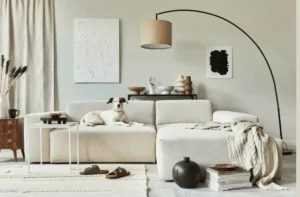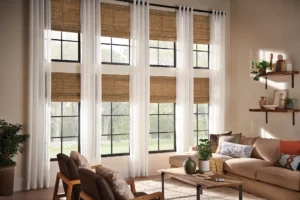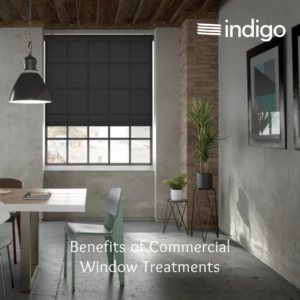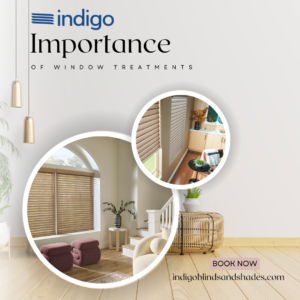Where Do I Start?
Set aside style considerations for a moment; drapery function comes first and will limit your curtain choices, in a good way. If you want treatments that provide privacy or total darkness, you need lined curtains.
If you’re OK with light filtering through or if your drapery is simply decorative, unlined will work. Lining is more expensive but has other advantages: It can shield fabric from sun damage, making curtains last longer. A lining also adds heft, which protects against drafts and helps fabric fall more luxuriously.
For maximum durability, light blockage, body, and insulation, you can get drapery with an interlining. A layer of flannel like fabric sewn between the lining and the “face” fabric. This is a common option for custom-made drapery but not widely available in less expensive ready-made panels.
Drapery is a powerful design tool—pulling together your room’s decor and expressing your own unique style and tastes.
Drapery vs. Curtains—What’s the Difference?
Two quick questions to consider when choosing between curtains and drapery:
1) Does the room require complete privacy—or will the bare minimum suffice?
2) What matters more—style or functionality?
We’ve compiled a quick cheat sheet to help you choose between these two similar, yet unique, styles so you can get one step closer to your perfect home design.
What are Curtains?
There are important details that make curtains unique. For starters, curtains are typically made with a light and unlined fabric, which leads to minimal light control and privacy. As to length, curtains are typically made pre-cut to purchase. Whether or not you want curtains that measure the length of the window or floor is ultimately up to you.
Lastly, curtains are typically hung in spaces that are informal or don’t require much privacy, such as a kitchen, sunroom, office, or entryway.
What is Drapery?
Draperies are custom made with a high-quality fabric, made to block light, dampen noise, and increase privacy. This treatment is known for its sophisticated and formal look, perfect for living rooms, bedrooms, movie rooms, and dining rooms.
Our drapes are custom cut to exact specifications depending on your preference and desired look.
You can choose how full you’d like your drapes and how long, which means you can accommodate any window in your home–even ones that might be considered.
What About Fabric and Color?
Texture: Consider the mood of the room. For a formal space, there’s heavy silk or velvet (a great insulator); both are dry-clean only. More practical (often washable) options include silky rayon blends and cotton sateen.
For a casual feel, there are billowy linen (generally dry-clean only) and crinkly crushed velvet. Cotton and cotton blends work with any type of decor and bring a crisp, neat feel, as does seasonless wool or wool blends.
Natural Fabrics
Cotton — The workhorse of drapery, this natural fiber can be used to create graceful sheer drapery as well as stiff, opaque fabrics that exude sturdiness and strength.
Linen — This natural fabric made from flax has a simple texture that evokes timeless style and tradition. It is very durable, but often develops folds and wrinkles over time. There’s nothing that looks quite like linen, which is why it remains a perennial favorite with homeowners.
Synthetic Fabrics
Polyester — This is the most versatile of all drapery materials. There’s nothing that can’t be created with polyester. You’ll find light-as-air versions of polyester fabric and thick, rich tapestries. It is among the most durable of all drapery materials, but lighter colors can stain more easily than other materials.
Rayon — This versatile fabric derived from wood pulp has properties of both silk and linen. Many richly textured fabrics utilize rayon.
Acrylic — Another versatile fabric that is highly durable. Acrylic can imitate wool but can also be woven into a tight knit that can withstand outdoor use.
Viscose — A hardworking, durable alternative to silk, this fabric is often used in delicate, textured fabrics.
So, What’s the Most Popular Fabric for curtains and drapery?
Variations of white as well as neutrals—browns, grays, and tans—are top choices for drapery fabric color. Combinations of blue and white are quite popular, as are sheers in white and ivory. But none of that matters if that’s not what you want in your home.
The color that speaks to you is the right color for you.
The base material of the fabric is of lesser importance. That’s because modern fabrics utilize a mix of innovative materials and processes to create cloth that is ideal for drapery. Using cotton, rayon, viscose, polyester, and acrylic, you can get the look, and even the feel, of linen or silk or wool—but with none of the disadvantages.
Choose color, then pattern, then texture—and if you make those choices based on your own unique preferences, you’re going to have no trouble finding the right fabric.
Color:
You’ll need to decide if you want the drapery to blend with the decor or to pop. For blending, pick curtains that are the same tone as the wall but a few shades darker, or choose a non-dominant subtle colour in the room (a soft shade from the rug, say).
A bold color will work like an exclamation point (if you’re looking to add some wow). Also keep in mind that in a space where the sun shines through unlined curtains, the colour will infuse the room. Blue can be eerie; pink, cheery.
Color Sets the Tone:
There’s no right color for drapery, but color matters more than any other single element. Your process for selecting a color should be guided by your tastes, your current décor, and your household needs. Check out the 2024 Color Trends: Here
Here are some general color options to get you started:
Warm Neutrals —A popular family of colors in which warm primary colors are mixed with blacks, browns, or greys to create a more subdued tone with an underlying sense of warmth.
Neutrals (Browns, Greys, Tans) — When you do not want your window treatments to take center stage, choose one of these neutral colors. Aside from white, this neutral palette is the go-to for homeowners seeking anything from the coziness of a country manor to the clean look of a high-rise apartment.
Greens and Blues — There is a calming nature to blue that makes it ideal for creating a subdued atmosphere. White and blue is one of the most popular color choices. Greens are similarly calming but also possess some refreshing energy. Both colors are easy on the eyes and can help to create a sort of oasis.
Warm and Cool Colors — Red can set a room aglow with energy. A cool lavender can convey calm and serenity. Warm or cool colors can coordinate with other décor elements or be highlighted against a light background.
White (in all its variations) — Last but not least. By far the most popular color of window treatment is white or some version of white. From sheer drapery to thick fabrics with textured weaves or bright patterns, white creates the perfect backdrop for just about any interior design scheme you can devise.
Prints and Patterns, A rule of thumb: If you have patterned furniture or bedding (or a very elaborate rug), stick with solid curtains. If you have solid-colour furniture or bedding, consider patterned curtains.
For a subtle hint of style and energy, go for a small, neutral print, like dots or paisley, which reads like texture from afar. A large, graphic print in a colour that relates to the existing decor is daring but can be spectacular.
How Long Should Curtains Be?
Floor-length is the way to go, unless there’s a radiator or a deep sill in the way. Ready-made panels are available in lengths from 63 to 144 inches.
Measure from the floor to where you’ll hang the rod, then round up. You can always have the dry cleaner hem them a bit if needed. You’ll get the most current look if the fabric makes contact with the floor (or sill or radiator). Too-short curtains can seem nerdy and off, like high-waters.
Here are two surefire approaches.
1: Just Hitting the Floor or Sill: This look is classic and tailored; it makes sense if you’ll be opening and closing the curtains a lot (they’ll easily fall back into place every time you move them). The fabric should just touch the floor or hover half an inch above.
This is also a great approach for café curtains (short panels that cover only the lower portion of a window and hit the sill), which work well in spots like the kitchen and bathroom, where long drapes aren’t practical.
2: Breaking Slightly at the Floor: Panels that extend onto the floor by one to three inches are the most stylish right now. They’re more relaxed than those that graze the floor (left), but they still feel tailored—think of a pair of dress trousers.
If you have uneven floors or are worried about precision measuring, this style is more forgiving. In formal rooms, an exaggerated take—six or so inches of fabric pooling on the floor can look romantic but is also high-maintenance. Curtains need refluffing every time you vacuum or the cat lies on them.
How Wide Should Curtains Be?
To ensure that panels look ample and drapey when closed, they should have a combined width that is 2 to 2½ times the width of the window. Exceptions: If you’re hanging curtains just to frame a window and don’t intend to shut them, you can round down to 1½ times the width.
Pleated panels have fullness built in, so their width should more or less match the span you’re covering.
Where Should Drapery Be Mounted In Relation to the Window?
Generally, hanging curtain brackets on the wall above and outside the window molding looks best; it allows fabric to fall gracefully. If you have detailed window frames you don’t want to cover, an inside mount (hanging curtains within the frame, as you would with a tension rod) can work.
Below are two hanging tricks that decorators love for maximizing windows—you can opt for just one technique or use both on the same window.
1: Hang Above the Frame: To create the illusion of a taller window, mount the rod four to six inches above the window frame—or halfway between the frame and the ceiling molding. But within reason—don’t go more than eight inches above the frame or it might look awkward.
A track mounted on the ceiling also lengthens windows. Be sure to account for the extra fabric when measuring.
2: Hang Wider Than the Frame: Extending the rod three to six inches beyond the frame on each side makes a window feel grander and allows extra light to stream in when the curtains are open (the fabric hangs against the wall without blocking the glass). You can also use this plan to reveal pretty molding.
In this case, you may want to leave as much as 12 inches on either side. Remember to adjust your width measurements for this look.
What About the Top of the Drapery?
The top hem of a curtain, known as the heading, can help define the overall look—casual or formal, feminine or sleek—and also play a part in functionality (allowing the panel to slide easily or not).
Here’s a quick rundown of common options.
1: Basic Heading, With Hooks: A traditional flat heading that attaches to the rod via rings stitched into its top hem or, sometimes, drapery hooks (the rings attach to the hooks). With either setup, the curtains move easily.
2: Rod-Pocket Heading: A channel along the top holds the rod and creates a casual, gathered effect. A nice choice for curtains that will stay put, because shimmying the fabric back and forth can be difficult.
3: Pleated Heading: There are many styles, from narrow pencil pleats to wide, flat box pleats. Because they’re structured, these panels read more formal than do other types. Pleated curtains generally operate with drapery hooks and rings.
4: Tab-Top Heading: Flat loops of fabric hang on the rod. This can look relaxed with sheers or buttoned-up with stiffer fabrics. A variation on this theme is tie-tops, with bows instead of flat loops—still casual but more feminine and romantic.
What Type of Rod Should I Use?
Decorative curtain rods should relate to the style of the room. Those that are completely hidden from view can be chosen based on function alone. Here are common options.
1: Classic Rod: An adjustable pole, often featuring ornamental end caps (finials), that attaches to the wall with brackets. Match the metal to other finishes in the room. You can buy a double-rod version if you want to layer with sheers.
2: Return Rod: An adjustable U-shaped rod that screws directly into the wall. Panels wrap around the curved sides, making this a good solution for blocking out light. Also available in a double-rod style for layering.
3: Track Rod: Drapery hooks attach to pulleys inside a track. Can be installed on a wall or the ceiling. Some tracks resemble a rod with finials, concealing all moving parts inside the pole. Curtains glide effortlessly.
4: Tension Rod: The easiest and cheapest but least sturdy option, it adjusts to fit inside a window frame with no hardware. Barebones, it’s meant only for lightweight panels or café curtains.
Do I Need Drapery Tiebacks?
If you want to be able to pull curtains to the side for more light or a swoopy, formal look, tiebacks are the answer. They’re also a nice way to showcase a view. Mount a curved metal bracket or a peg (known as a rosette) on the wall about two-thirds of the way down the window.
Match the room and the rod for style and finish. There are simple fabric tiebacks and fancy ropes with tassels for a grander effect. More casual: tying a curtain in the center of a window with matching fabric or a wide grosgrain ribbon.
Five Reasons Why You Should Layer Your Window Treatments.
There are many reasons to pair drapery with other types of window treatments, reasons ranging from practical to purely aesthetic.
1. Adding Insulation: Traditional drapery and natural drapery do an excellent job of insulating against heat, cold, and sound. By adding drapery to a roller shade, for example, you can cut down on heat and cold escaping along the sides of the shade.
2 . Versatility: By adding drapery to a shade, you increase the number of ways you can control light and privacy. For example, when your shade is open, you can let a set of sheer drapery provide some light filtering and a bit of privacy.
Or, if you want to block the light coming through a light-filtering cellular shade, closing a set of room-darkening curtains will do the trick.
3. Layers of Color: Adding drapery gives you another opportunity to play with color, pattern, and texture. You can contrast your shades with your drapes by picking complementary colors or patterns that create energy and visual interest.
Subtle color differences can also be effective and can be coordinated with other elements of the room for a harmonious effect.
4. Creating Depth: Adding drapery to a shade provides a sense of depth that is pleasing to the eye. Roman shades and drapery in matching fabric (a stunning look that exudes elegance) is captivating because of the layers and shadows.
Drapery adds a three-dimensional, sculptural touch that no other window treatment can.
5. Visual Interest: The addition of drapery to any window adds visual interest. The folds and draping of fabric has fascinated artists and sculptors for thousands of years. For good reason: the shapes and patterns are pleasing to the eye and defy total understanding.
The secret is in the complexity and randomness. Fabric can be mesmerizing.
Other Things to Look For — Five More Fabric Features
1. Durability: Many fabrics made purely of one material can have vulnerabilities that greatly affect the fabrics’ durability. To counteract these vulnerabilities, Graber uses a mix of materials to create drapery that hangs better, lasts longer, and looks exquisite.
2. Light Control & Light Filtration: What if you want some sunlight in the room—but still want privacy? Enjoy a level of privacy as well as light filtering with a sheer fabric. A sheer fabric can afford excellent light penetration while maintaining some view to the outdoors—served up with an elegance that’s hard to beat.
Go to a less sheer fabric for greater light filtering and increased privacy.
3. Insulation Against Heat & Cold: Drapery of all types will help protect against the heat and the cold. Drapery with a lining can provide excellent insulation, and special-purpose liners can boost that performance.
Thicker fabrics do a better job of insulation, but all drapery can have a positive effect on your home’s energy efficiency. Drapery stops drafts and protects against the sun’s heating rays.
4. Maintenance: All of our custom window treatments are built to last. But you can extend the life of your drapery by periodically cleaning them.
The first thing to know about maintaining your drapery is that it should not be washed. Although decorative fabrics are tough, they are not meant to stand up to a washing machine or being washed in soap and water.
The trick to cleaning drapery is consistency. Every time your clean your home, take a minute to vacuum your drapery with the upholstery attachment. This will remove any accumulated dust and reduce the need for a deep cleaning.
But, if a deep cleaning is necessary, take your drapes to a dry cleaner who is experienced in cleaning drapery.
One note about sheer fabrics. Sheer drapery is made with the thinnest of all fabrics, and therefore the most delicate. When vacuuming, the upholstery brush might not be gentle enough for your sheer drapes.
Instead, try using a handheld vacuum—with its lower suction, there’s less chance of the handheld vacuum inhaling your delicate sheer drapes.
5. Style That Lasts: Fashions come and go. But there are some styles of décor that seem to be timeless. The Traditional home-decorating style, with its warmth and European roots, has been the go-to choice for millions of homeowners. The Modern style, with its straight lines, contrasting darks and lights, and Scandinavian influences, has been around for decades.
But, all it takes is a quick perusal through some old magazines to see that there are some other styles of interior design that no one wants to think about anymore.
So, when selecting your drapery, you might want to keep in mind the future. If you’re looking for a style that lasts—so you don’t have to redesign your room anytime soon—choose something Traditional or Modern or some version of those two venerable styles.
What About Drapery Installation?
Use Professional Window Treatment Experts that can install everything for you!
For the first time, you can preview window treatments on your very own windows—with the new Graber Visualizer. Simply upload a photo, choose a treatment, and see how it looks in your actual space.
Change colours, options, and more to find the best window treatment solution for you.
No photo? No problem. Choose from our sample room scenes and bring your design vision to life. WINDOW TREATMENT VISUALIZER
Order FREE Swatches directly from Graber: HERE






